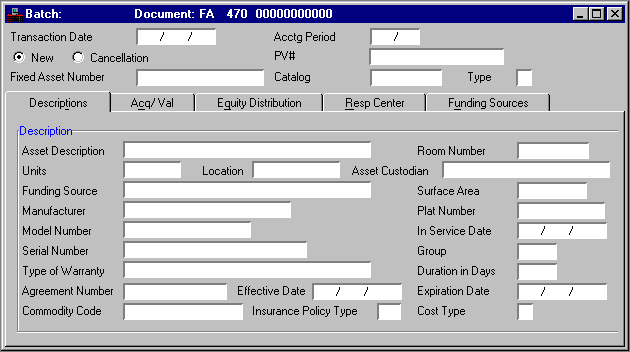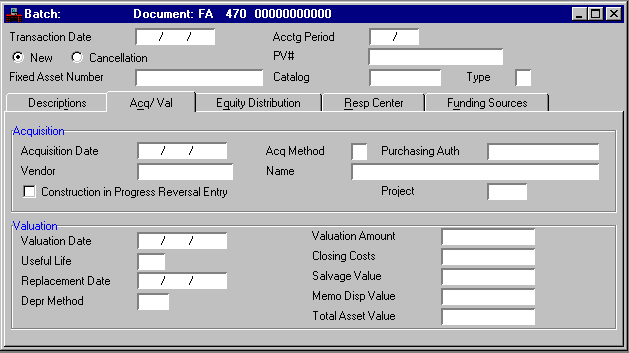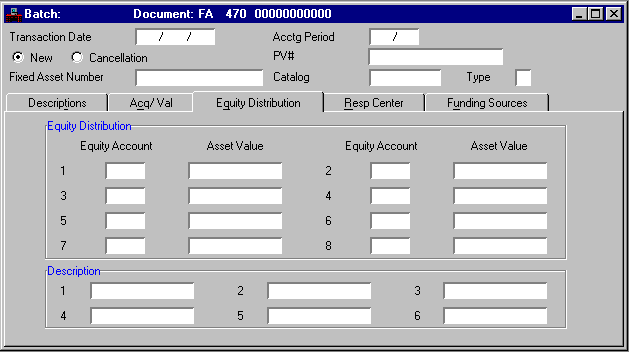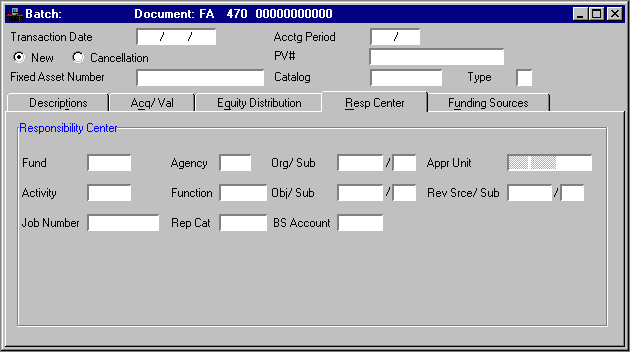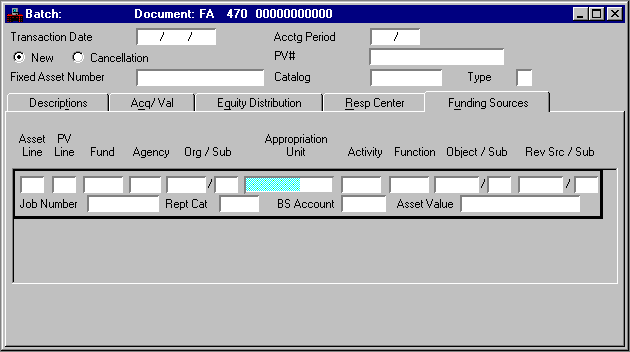|
|
|
|
Transaction Date
|
Defaults to the current date. Enter the effective date (
mm dd yy
) of the document.
|
|
Acctg Period
|
Defaults to the period in which the
Transaction Date
falls. Enter the accounting period to which the transaction is posted.
|
|
New/Cancellation [Action]
|
Defaults to
New [E]
. Valid values are:
New [E]
You are entering a new fixed asset.
Cancellation [X]
You are reversing an incorrectly entered fixed asset.
|
|
PV#
|
Required. Enter the payment voucher document number. See Open Payment Voucher by Document (OPVD) for valid values. Enter None if the asset is donated or confiscated.
|
|
Fixed Asset Number
|
Required. In combination with
Type
, this forms the unique identifier of the fixed asset.
|
|
Catalog
|
Optional. Enter the catalog code of commonly used assets. See Fixed Asset Catalog (FCLG) for valid values.
|
|
Type
|
Default is inferred from Fixed Asset Catalog (FCLG) if
Catalog
is entered. Otherwise, enter a valid type for this fixed asset. See Cost Type (CTYP) for valid values.
|
|
|
|
Description
|
|
Asset Description
|
Default is inferred from Fixed Asset Catalog (FCLG) if
Catalog
is entered, or from the payment voucher if this Fixed Asset Acquisition (FA) is created automatically by a payment voucher document. Otherwise, enter a description of the fixed asset.
|
|
Room Number
|
Optional. Enter the room number associated with the fixed assets.
|
|
Units
|
Default is
1
. This field allows you to capitalize several identical fixed assets acquired at the same time in one entry. Enter the number of fixed assets recorded in this transaction.
|
|
Location
|
Required. Enter the location of the fixed asset. See Fixed Asset Location Inquiry (FALC) for valid values.
|
|
Asset Custodian
|
Optional. Enter the employee's name or the position number. If left blank, this field defaults to "None."
|
|
Funding Source
|
Optional. Enter a description of the funding source.
|
|
Surface Area
|
Conditional. Optional if
Type
is
L
(land),
B
(buildings
)
,
I
(improvements) or
C
(construction).
Enter the area (for example: 200 sq. ft.). Leave this field blank for all other types of fixed assets.
|
|
Manufacturer
|
Conditional. Optional if
Type
is
E
(equipment) or
V
(vehicle). Enter the manufacturer. Leave this field blank for all other types of fixed assets.
|
|
Plat Number
|
Conditional. Optional if
Type
is
L
(land),
B
(buildings
)
,
I
(improvements) or
C
(construction). Enter the plat number. Leave this field blank for all other types of fixed assets.
|
|
Model Number
|
Conditional. Optional if
Type
is
E
(equipment) or
V
(vehicle). Enter the model number. Leave this field blank for all other types of fixed assets.
|
|
In Service Date
|
Optional. Enter the date (
mm dd ccyy
) that the fixed asset was entered into service used to determine the start date of depreciation. If blank, depreciation will start on the acquisition date..
|
|
Serial Number
|
Conditional. Optional if
Type
is
E
(equipment) or
V
(vehicle). Enter the serial number. Leave this field blank for all other types of fixed assets.
|
|
Group
|
Conditional. Required only for agencies using the asset hierarchy. Default is inferred from Fixed Asset Catalog (FCLG) if
Catalog
is entered. Otherwise, enter the fixed asset group. See Fixed Asset Group (FGRP) for valid values.
|
|
Type of Warranty
|
Optional. Enter the type of warranty obtained when the asset was acquired.
|
|
Duration in Days
|
Optional. Enter the duration in days of the warranty.
|
|
Agreement Number
|
Optional. Enter the maintenance number.
|
|
Effective Date
|
Optional. Enter the date on which the agreement goes into effect (mm dd ccyy).
|
|
Expiration Date
|
Optional. Enter the date on which the agreement expires (mm dd ccyy).
|
|
Commodity Code
|
Required. Enter the commodity code of the fixed assets. Data will carry over from Procurement Desktop (PD). If the FA Document is being generated, users must enter the Commodity Code or "None."
|
|
Insurance Policy Type
|
Required. Enter the insurance policy type of the fixed assets. See Insurance Policy Type (ITYP) table for valid values.
|
|
Cost Type
|
Required. Enter the cost type for the fixed assets. See Cost Type (CTYP) Table for valid values.
|
|
|
|
Acquisition
|
|
Acquisition Date
|
Required. Enter the date (
mm dd ccyy
) when the fixed asset was acquired. For depreciable assets, this is the date the depreciation process recognizes as the first day of the asset's useful life when the in service date is blank.
|
|
Acq Method
|
Required. Enter the method of acquisition. See Acquisition/Disposition (FADM) for valid values.
|
|
Purchasing Auth
|
Required. Enter the purchase order number used to purchase the fixed asset.
|
|
Vendor
|
Optional. Enter the vendor from whom the fixed asset was purchased. See Vendor Index (VEND) for valid values.
|
|
Name
|
Default is inferred from Vendor Inquiry (VEN2). Optional when miscellaneous vendor code is used.
|
|
Construction in Progress Reversal Entry
|
Default is cleared [
N
]. Select [
Y
] if the system needs to make a Construction In Progress (CIP) reversal entry to the project's Construction In Progress (CIP) balance sheet account for the proprietary, internal service, or enterprise fund.
|
|
Project
|
Not used in MARS.
|
Valuation
|
|
Valuation Date
|
Optional. Enter the date (
mm dd ccyy
) that the fixed asset was valued.
|
|
Valuation Amount
|
Conditional. Required if
Valuation Date
was entered; otherwise, leave this field blank. Enter the insurance or estimated value of the fixed asset.
|
|
Useful Life
|
Default is inferred from Fixed Asset Catalog (FCLG), if
Catalog
is entered. Required if
Depreciation Indicator
on FATP is set to [Y] and
Type
is
NOT
L
(land) or
C
(construction); otherwise, leave this field blank. Enter the useful life of the fixed asset in years. This number is used by the depreciation process.
|
|
Closing Costs
|
Optional. If
Type
is
E
(equipment) or
V
(vehicle), leave this field blank. Otherwise, enter the portion of the acquisition cost that is associated with legal fees, commissions, etc.
|
|
Replacement Date
|
Optional. If a depreciation method is specified (SL, SY, DD, MC), enter the expected replacement date
(
mm dd ccyy
) of the fixed asset.
|
|
Salvage Value
|
Optional. If
Type
is
L
(land) or
C
(construction), leave this field blank. Enter the salvage value of the asset. This number is used by the depreciation process.
|
|
Depr Method
|
Default is inferred from Fixed Asset Catalog (FCLG), if
Catalog
is entered. Required if
Depreciation Indicator
on FATP is set to [Y] and
Type
is not
L
(land) or
C
(construction), leave this field blank. If the Depreciation Indicator is set to [Y], the default is 'Straight Line'. Enter the depreciation method that is used by the depreciation process. Valid values are:
SL
Straight Line
SY
Sum of the Years Digits
DD
Double Declining Balance
MC
Manually Computed
NA
Not Applicable. If this field is blank, this field defaults to
NA
.
nnn
Where
nnn
is a declining balance rate (for example: 200 for a double declining balance rate)
|
|
Memo Disp Value
|
Optional. Enter the estimated value of the asset when it is disposed.
|
|
Total Asset Value
|
Required. Enter the sum of the asset values on the next screen.
|
|
|
|
Equity Distribution
|
|
Equity Account (1)
|
If the Fund on the Responsibility Center Panel is established on Fund (FUN2) with a
Fund Type
of
I,E,N,A
, or
P
, then the
Retained Earnings
account from System Special Accounts (SPEC) is inferred. Otherwise, the
Investments in General Fixed Assets
account is inferred from System Special Accounts (SPEC).
|
|
Equity Account (2-8)
|
Enter a balance sheet account representing the ownership of the asset. Ensure that this account is valid on Balance Sheet Account Index (BACC) and has an account type of
03
(fund balance).
|
|
Asset Value
(1-8)
|
Required. Enter the proportion of the total asset value in dollars associated with each equity account.
|
|
Description
(1-5)
|
Optional. Enter descriptive text in the description fields.
|
|
Description
(6)
|
Optional. Enter the vehicle plate number or agency internal ID/tag number.
|
|
|
|
Responsibility Center
|
|
Fund
|
Required. Enter the appropriate proprietary or governmental fund. See Fund Index (FUND) for valid values.
|
|
Agency
|
Required. Enter the agency that is primarily responsible for the fixed asset. See Agency Index (AGCY) for valid values.
|
|
Org/Sub
|
Required. The agency/organization/fiscal year combination must exist on Organization (ORG2). Sub-Organization can only be entered if Organization is entered; otherwise it is blank. See Sub-Organization (SORG) for valid values.
|
|
Appr Unit
|
Required. Enter the Program Budget Unit element for the items listed on this voucher. See Program Reference Table (PRFT) for valid values. The Appropriation Program element and Allotment Program element will be inferred from PRFT based on Program Budget Unit.
|
|
Activity
|
Optional. Enter the activity that is primarily associated with the fixed asset. See Activity Index (ACTV) for valid values.
|
|
Function
|
Optional. See Function (FUNC) for valid values. If left blank, it is inferred from Organization (ORG2); or from Activity (ACT2), if a function code is not entered on Organization (ORG2).
|
|
Obj/Sub
|
Enter the object code on the acquisition, otherwise leave blank. See Object (OBJ2) for valid values. Sub-Object can only be entered if Object is entered; otherwise it is blank. See Sub-Object (SOBJ) for valid values.
|
|
Rev Srce/Sub
|
Conditional. Enter a revenue source on an internal refund transaction; otherwise, leave blank. When revenue source is entered, Object and Balance Sheet Account must be blank. See Revenue Source Index (RSRC) for valid values.
Enter a sub-revenue source if Revenue Source is entered and Sub-Revenue Source Required is Yes [Y] on Revenue Source (RSR2). If Sub-Revenue Source Required is No [N], sub-revenue source is optional. See Sub-Revenue Source (SREV) for valid values.
|
|
Job Number
|
Conditional. Organizations and activities can be defined to require the entry of a job number. Refer to Organization (ORG2) or Activity (ACT2) for details.
Otherwise, this field is optional. If
Job Cost
is
Yes [Y]
on System Control Options (SOP2), enter a job number. See Job Index (JOBT) for valid values. If
Job Cost
is
No [N]
on System Control Options (SOP2), enter a project number or general reporting category.
|
|
Rept Cat
|
Conditional. This field required on expenditure transactions if Reporting Category on Agency (AGC2) is Required on Expenditure Transactions [3].
This field is required on revenue transactions if Reporting Category Required on Revenue Transactions is Required [Y]. For transactions that require a balance sheet account code, this field is required if Reporting Category Option is Y (required) on Balance Sheet Account Index (BACC). Otherwise, this field is optional. See Reporting Category (RPTG) for valid values.
|
|
BS Account
|
Conditional. Enter a balance sheet account if this is an expense transaction (fixed assets) or if this transaction transfers funds between two balance sheet accounts.
If the latter is the case, Object must be blank. See Balance Sheet Account Index (BACC) for valid values. You cannot enter a balance sheet account that is used as a default account on System Special accounts (SPEC). However, you can enter the default fund balance account.
|
|
|
|
Funding Source View
|
|
Asset Line
|
Required. Enter the appropriate line number.
|
|
PV Line
|
Optional. Enter the line number of the referenced Payment Voucher. The line number must be a valid Payment Voucher line number. If the payment voucher is
None
, leave this field blank.
|
|
Fund
|
Required. Enter the appropriate fund. A maximum of 99 funding sources are allowed. See Fund Index (FUND) for valid values.
|
|
Agency
|
Required. Enter the code of the agency whose funds were used to purchase the asset listed in this document. See Agency Index (AGCY) and Fund Agency Index (FAGY) for valid values.
|
|
Org/Sub
|
Optional. If entered, the agency/organization/fiscal year combination must exist on Organization (ORG2). Sub-Organization can only be entered if Organization is entered; otherwise it is blank. See Sub-Organization (SORG) for valid values.
|
|
Appropriation Unit
|
Required. Enter the Program Budget Unit element for the items listed on this voucher. See Program Reference Table (PRFT) for valid values. The Appropriation Program element and Allotment Program element will be inferred from PRFT based on Program Budget Unit.
|
|
Activity
|
Optional. Enter the activity that is primarily associated with the fixed asset. See Activity Index (ACTV) for valid values.
|
|
Function
|
Optional. See Function (FUNC) for valid values. If left blank, it is inferred from Organization (ORG2); or from Activity (ACT2), if a function code is not entered on Organization (ORG2).
|
|
Object/Sub
|
Enter the object code on the acquisition, otherwise leave blank. When Object is entered, Rev Srce and BS Acct must be blank. See Object (OBJ2) for valid values. Sub-Object can only be entered if Object is entered; otherwise it is blank. See Sub-Object (SOBJ) for valid values.
|
|
Rev Srce/Sub
|
Conditional. Enter a revenue source on an internal refund transaction; otherwise, leave blank. When revenue source is entered, Object and Balance Sheet Account must be blank. See Revenue Source Index (RSRC) for valid values.
Enter a sub-revenue source if Revenue Source is entered and Sub-Revenue Source Required is Yes [Y] on Revenue Source (RSR2). If Sub-Revenue Source Required is No [N], sub-revenue source is optional. See Sub-Revenue Source (SREV) for valid values.
|
|
Job Number
|
Conditional. Organizations and activities can be defined to require the entry of a job number. Refer to Organization (ORG2) or Activity (ACT2) for details.
Otherwise, this field is optional. If
Job Cost
is
Yes [Y]
on System Control Options (SOP2), enter a job number. See Job Index (JOBT) for valid values. If
Job Cost
is
No [N]
on System Control Options (SOP2), enter a project number or general reporting category.
|
|
Rept Cat
|
Conditional. This field required on expenditure transactions if Reporting Category on Agency (AGC2) is Required on Expenditure Transactions [3].
This field is required on revenue transactions if Reporting Category Required on Revenue Transactions is Required [Y]. For transactions that require a balance sheet account code, this field is required if Reporting Category Option is Y (required) on Balance Sheet Account Index (BACC). Otherwise, this field is optional. See Reporting Category (RPTG) for valid values.
|
|
BS Account
|
Conditional. Enter a balance sheet account if this is an expense transaction (fixed assets, consumption-based inventories, pre-paid items) or if this transaction transfers funds between two balance sheet accounts.
If the latter is the case, Object must be blank. See Balance Sheet Account Index (BACC) for valid values. You cannot enter a balance sheet account that is used as a default account on System Special accounts (SPEC). However, you can enter the default fund balance account.
|
|
Asset Value
|
Required. Enter the proportion of the total asset value in dollars associated with each equity account. This value must equal
Asset Value
on the Acquisition/Valuation panel.
|




